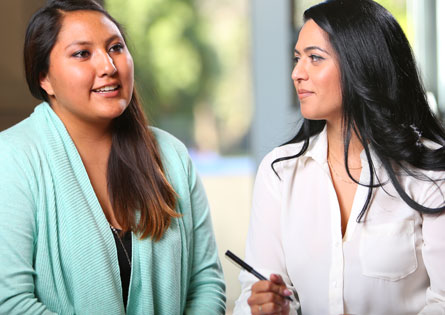Arizona’s Latino students trail their White peers in almost every education assessment category. Only 69 percent of Latino students graduated high school on time compared to more than 76 percent of non-Latinos, 65 percent of Latino adults lack post-high school training and only nine percent of Latino adults have a bachelor’s degree or higher1.
Arizona has the fourth largest concentration of Latinos behind New Mexico, California and Texas. At 44 percent, Latinos make up the largest proportion of the state’s population of children. Latino children outnumber White children in the state’s public schools2.
In response to these statistics, Helios launched the Excel Initiative in partnership with the Maricopa County Community College District, one of the largest community college districts in the country. The Maricopa Community Colleges enroll more Latino undergraduate students than do Arizona’s three state universities combined (Arizona State University, the University of Arizona and Northern Arizona University). The Initiative has focused on improving the academic preparedness, achievement and attainment of Arizona’s Latino students.
Helios’ partnership with the Maricopa County Community College District includes comprehensive student supports and resources, such as financial assistance, mentoring and academic support, opportunities for parent and family engagement, academic planning and other services.
Vince Roig, Founding Chairman, Helios Education Foundation
While I am encouraged by everything that has been done to better prepare Arizona’s students for the future, I am concerned about the growing disparity in the academic achievement of our Latino students. With Helios’ new partnership with Maricopa County Community Colleges District, we are putting a stake in the ground around the importance of ensuring all students have the opportunity to succeed because their academic success will determine the future economic success of Arizona.

Helios Announces $2 Million Partnership to Increase Latino Degree Attainment
Helios Education Foundation's investment of $2 million in the Maricopa County Community College District provides $1.5 million for the Excel Initiative to help ensure more Latino students in Arizona achieve a college degree and $500,000 to implement a reverse transfer project in which students who transfer to a university with at least 45 credits from a Maricopa Community College can retroactively receive an associate degree, thus providing them with a postsecondary credential that can open doors to additional job opportunities.
- Hart, B. & Eisenbath Hager, C.J. Dropped? Latino Education and Arizona’s Economic Future (2012), Retrieved from https://morrisoninstitute.asu.edu/products/dropped-latino-education-and-arizonas-economic-future
- U.S. Census Bureau (2013). American Community Survey. Generated March 12, 2015. From //www.census.gov/acs/www/
According to a recent longitudinal study from the Arizona Board of Regents, 43.5 percent of students who graduated from public high schools in 2005-2006 had not pursued any postsecondary education within six years of graduating1. The reasons that students do not pursue postsecondary education vary, but they often center on a weak college-going culture, including inadequate academic preparation, a lack of understanding of the enrollment process and a general unawareness of the economic benefit of college attendance.
In order to help develop a college-going culture on high school campuses in Arizona as well as provide valuable data on the college and career readiness of students, Helios has funded the administration of the ACT exam to all juniors in 14 school districts across Arizona. To date, more than 87,000 students have taken the exam since Helios began funding it in 2009.
This initiative has increased access to the exam from two percent in 2008 to 20 percent in 2013, and has increased the number of males, students of color and students from low-income families taking the ACT. School district leaders participating in the program indicate that providing access to the ACT for all high school juniors is aligned with ongoing efforts to create a college-going culture on high school campuses.
Since 2009, a significant body of data has accumulated around student performance on the ACT. These early learnings have inspired the desire for more in-depth analysis of the available academic performance data and postsecondary-going behaviors of students within the participating districts. In late 2013, the Foundation launched a formal evaluation of the project to provide a more substantive assessment. The goal of that research is to assess the college and career readiness of Arizona students and to further understand whether this work is having an impact on student’s pursuing postsecondary education opportunities. Results of that study will be released later this year.
Dr. Stacy Carlson, Vice President and Program Director, College and Career Readiness, Helios Education Foundation
Increasing access to the ACT fosters college-going conversations with more students and provides valuable data on the academic preparedness of students in pursuit of a postsecondary education.

Over a seven-year period, Helios has invested over $2.9 million dollars in the ACT District Choice State Testing initiative in partnership with 14 Arizona school districts and ACT. Helios funding has supported more than 87,000 students in taking the ACT assessment, contributing to broader conversations about college preparation and readiness.
One of the reasons middle and high school students disengage is that they don’t see the connection between what they are learning in the classroom and its application in the workforce. Helios is collaborating with multiple partners including the Pinellas Education Foundation and the Pinellas County Schools in Florida, to change student perceptions and help them identify 21st century careers aligned with their interests.
The initiative, called Future Plans™, is a comprehensive college and career guidance program incorporating electronic tools to evaluate student aptitudes, values and interests in alignment with 21st century careers. The program enables students to make informed decisions about coursework during high school to better position themselves for postsecondary education success and career opportunities. The goals include increasing the number of students leaving high school with an educational plan from six percent to 90 percent by the 2017-2018 academic year.
The program is being implemented across all 17 high schools in Pinellas County and is estimated to serve more than 8,000 11th grade students in the first year. Within five years, Future Plans™ will have served more than 40,000 Pinellas County 11th grade students.
Dr. Stacy Carlson, Vice President and Program Director, College and Career Readiness, Helios Education Foundation
Future Plans™ not only enables students in Pinellas County to make informed decisions about coursework during high school, it better positions students for postsecondary education success by linking their academic preparation to 21st century careers.

Helios invested $1.25 million in the Future Plans™ initiative, which is a collaborative effort between Pinellas County Schools and the Pinellas Education Foundation to provide college and career guidance for high school students, evaluating their aptitudes, values and interests in alignment with 21st century careers.
More than five percent of Arizona’s population is American Indian, which is higher than the national average of just over one percent. Schools that are on or near tribal lands tend to be rural and are likely to be remote. In addition, on average, 44 percent of American Indian children live in poverty1.
American Indian student achievement is consistently lower at all grade levels compared to their peers and only two out of three American Indian students in public schools will graduate from high school1. These facts make American Indian students an important population for Helios as the Foundation works to ensure that all students have access to a high-quality education and achieve postsecondary education success.
In 2014, Helios partnered with the Intertribal Council of Arizona to hold a summit and conduct follow-up research on the rigor and relevance of American Indian education in anticipation of the implementation of Arizona’s College and Career Ready Standards.
More than 80 representatives from 22 tribes in Arizona came together to begin critical conversations on how tribal nations and communities can proactively respond to the higher standards in a way that ensures greater success for American Indian students. This partnership is helping Arizona’s Tribal nations identify and provide the academic supports needed as it takes greater control of its education goals, priorities and systems.
Barbara Ryan Thompson, Executive Vice President and Chief Operating Officer, Helios Education Foundation
As Arizona is implementing higher and more rigorous standards, it is critical that the community recognizes and plans for the impact on all students, but especially on American Indian students who, by all indications, are an academically vulnerable population.

Rigor and Relevance in Indian Education
Helios invested $85,000 to support research, data gathering and reporting on Indian education in Arizona. The overall goals of this partnership were to provide a baseline of the current status of K-12 Indian education in Arizona and to use this information as the foundation for a strategic Indian education summit focused on improving American Indian student achievement and academic success.
- Rigor and Relevance in Indian Education: A Pathway to Strengthening Communities. Retrieved from //azednews.com/wp-content/uploads/2014/07/State-of-Ind-Ed-Prelim-Report-FINAL.pdf
